The Best Airplane in the World
![]()
The Best Airplane in the World |
|
by Fernando Almeida.
Translation by Luiz Guiherme Richieri.
This article appeared in the Brazilian Voar magazine, in the spring of 1987. |
At 70 knots indicated, I turn from base to final, power off, lining up the plane right on the centerline of runway 18 at Wittman Field. My linkage to the flying machine is through my left thumb and index finger, very gently-like you would hold an injured bird by its neck. Millimetrically calculated move-ments, including the rudder inputs, right hand on the throttle, each and every nerve of my body is tuned to the reactions of the airplane. Her response is prompt to the most subtle touch, but an aerodynamic annoyance is clearly evident when such a machine feels she is treated like a common airplane.
Seconds later, the little speedster touches the asphalt with conviction, mains first. I make an intentionally long landing, after some floating in ground effect, stretching to the end the pleasure of piloting again the best airplane in the world-the F.8L Falco, a work of art by a genial designer, Dottore Ingeniere Stelio Frati.
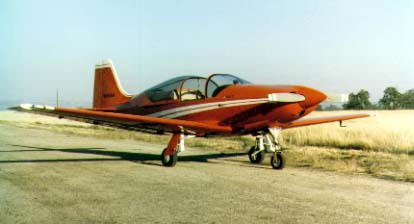
Two days before, during the extraordinary aeronautical delirium of Oshkosh, I was invited to fly Karl Hansen's red Falco N805SH, the same airplane depicted in the Sequoia advertisments. Alfred Scott, the father of the homebuilt Falco, introduced me to Karl Hansen, a retired USAF pilot and first-time homebuilder. In the middle of our lively talk about the virtures and defects of the Glasair, Vari-Eze and Falco, Karl Hansen turned to me and said, "You need to fly a real Falco."-He knew I had already flown Alfred Scott's old Falco-"How about testing my airplane?" We set up our flight for two days later.
Eleven o'clock in the morning, a nice warm 25° C, the blue sky above us is filling with white cumulus, like giant popcorn over the green fields of Wisconsin. I follow Karl to the briefing room in a small wooden house near the taxiway. An adrenalin charge comes when Karl says, "You fly the left seat, son." The only problem is that I'll have to fly the Falco with my left hand on the stick and the right on the throttle.
The tower instructions for getting into and out of the pattern are precise, and we get a small card containing the basic VFR directives for our departure, something a lot simpler than the departures and arrivals at Marte Field at São Paulo. Beside me a familiar figure is talking on the telephone-Chuck Yeager himself, asking somebody on the other end not to forget to feed the dog.
Falco November 805 Sierra Hotel is waiting for us in the grass parking area in front of the tower. There are two more Falcos, one on each side of Karl's, a blue and white one, built by Jim DeAngelo, who flew with Stelio Frati at Oshkosh '85, and the other one, Ray Purkiser's white and violet machine.
I follow Karl Hansen through the preflight, amazed at the superb finish and at the sensuous lines of the machine. He drains the two fuselage tanks and checks the oil level, when Alfred Scott joins us and shows the perfect fit of the cowling-an incredible harmony of lines in the Frati tradition of form and function, beauty and efficiency. The Falco sits low on the ground, supported by the short trailing-link main gear legs. This makes the elegant nose very high, arrogant, in a pronounced pitch-up attitude-the machine seems to want to leap into the air! The controls are feather light, the gaps are minimal, and the wing fillet and the sliding canopy are a flowing beauty.
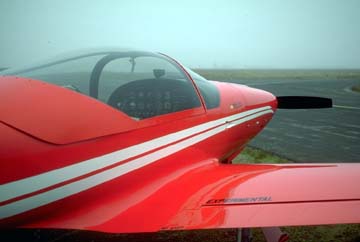
It reminds me of something an old friend of mine used to say, except he always said it referring to the Bücker Jungmann: a bunch of wild inhabitants from some lost tribe suddenly find themselves before a Falco in a clearing in the middle of the jungle. Their comments would probably be, "We've never seen this before. We don't know what kind of beast this is, but one thing is for sure, it flies!"
I gently caress the fluid lines of the fuselage, following the subtle curve of the dorsal fin, starting right aft of the canopy. Karl Hansen explains to me that this airplane is equipped with a 160 hp Lycoming IO-320-BIA. He also has a Christen inverted oil system and a two gallon header tank for inverted flight. With a constant speed prop and an all-wood structure stressed for plus six and minus three g's, Falco N805SH is approved for unlimited aerobatics up to a maximum weight of 1,650 lbs and cruises at more than 206 mph. This is almost twice as fast as my Beech Sundowner which has 20 more horsepower on its nose!
The canopy is open, after having been slid back very gently. The red machine invites me to take her right there, on the green grass. A little carpet strip is thrown on the wing to keep me from stepping on the painted wood on entering the cockpit. Now, all we have to do is ask the folks sitting on the grass to help us open up a way out for our Falco. The response is prompt and soon we have a clear way ahead. There is a spark in the eyes of those who share such moments-the ritual of the perfect machine preparing to take to the air.
While I get used to my position on the left seat, Karl and Alfred push the Falco carefully through the grass to the pavement while I ride the rudder pedals, experiencing the quite restricted visibility over the nose. Toe brakes exist only on the left side. The cockpit is comfortable, with the feel of a Ferrari sports car. The finish and trimming are impeccable. The seats are adjustable fore and aft but have a too-reclined back which is a problem for me. It is difficult to reach the gear switch on the left or the flap lever on the right, under the pedestal. The seat belts are of the acrobatic five-point type, stressed for 40 g's. The shoulder harnesses are not inertially actuated, but there is a small lever that frees them in case the pilot needs to lean forward. The stick is S-shaped, like in a helicopter, but with too tall a grip, forcing me to fly with my thumb and index finger below the stick grip, so that my wrist lies on my left thigh for more lightness on the contols-a requisite for the Falco.
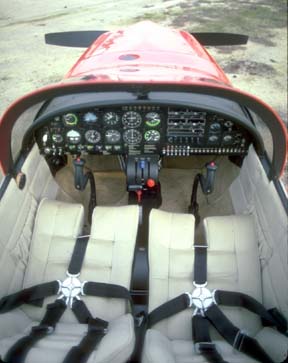
The panel is very professional -modern instruments in a correct layout, King avionics, including dual navcoms, glide slope, DME, transponder and marker beacon receiver. The airspeed indicator, g-meter and turn & bank are right in front of the pilot. The tachometer and manifold pressure are very visible, on the center of the panel. We've got a digital OAT, EGT, flowmeter with totalizer-everything logically displayed on the panel along with the other engine instruments and the usual paraphernalia of switches and circuit breakers.
We are ready now. The Lycoming starts easily, and the vibration level is low. I taxi slowly along the paved taxiway with the canopy open, in a smooth ritual of assimilation and domain. We wait for a yellow Stearman to take off, then the signalman clears us into position in front of a long, eclectic line of airplanes waiting for takeoff. We've got no time for a complete run-up, just a quick check of the mags, instruments, flaps and trim, during the roll. Canopy checked closed and latched, we have the two 20-gallon tanks almost full, plus the small inverted tank. Karl and I together weigh about 375 lbs. That puts the Falco a little over the 1650-lb maximum acrobatic weight. A light right crosswind of some 8 knots, throttle full forward, the acceleration is brisk for 160 hp. A little right rudder to track the centerline, I observe the Falco's attitude during the ground roll, about 5° of "natural" pitch up accompanied by the feeling of dragging the tail on the asphalt, so low is the airplane. This observation will be fundamental when it comes time to land.
At 65 kts, I pull lightly on the stick and the machine jumps into the air, reminding me of its sensitivity in pitch. We accelerate to 80 knots, brakes on, gear up. Karl completes the electric motor action by manually turning a small crank between the seats, to make sure the gear doors are fully closed. I level off at 500 feet, still accelerating. The Stearman ahead seems to have stopped in the air. We pass by him like a bolt of lightning. The trim wheel between the seats doesn't need to be used, the airplane is practically insensitive in pitch to the gear position, and even to the flap position, as I would find out later.
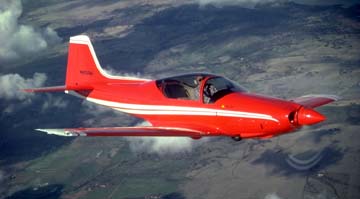
And what superb controls! Quick, light ailerons makes rolling a natural pleasure. They remind me of the Bücker and the Pitts S2A, but without the adverse yaw. The rudder pedals are almost unnecessary! We leave Wittman Field on a heading of 180°, to be able to climb to a higher altitude. I firewall the controls to 2,700 rpm and 26 inches which produces 1,500 fpm on the VSI, with 90 knots and a light pressure on the right rudder pedal. I feel impatient and observe that at 100 knots and 25/2500 the Falco still climbs at 1,100 fpm as naturally as an enraged hawk. At the 4,500-foot base of the cumulus, I level off and look for an open corridor between the clouds, circling over Lake Winnebago.
Things happen quite fast in a Falco. At 25 square the airspeed indicator rides up to 165 knots. We have 23° C on our OAT, and our density altitude is around 6,000 feet. That gives us a true airspeed of 181 knots without too much effort-208 mph at 75% power! Firewall the throttle and prop to maximum power, and the Falco accelerates to 175 knots indicated -220 mph true. That's fantastic, but Karl promises more speed with additional drag reduction work he plans to do. What is incredible is that even at 2,100 rpm and 21 inches of manifold pressure, we can still cruise at 186 mph true sipping a mere 6.7 gallons per hour. That's almost 28 miles per gallon. This is what I call "efficiency".
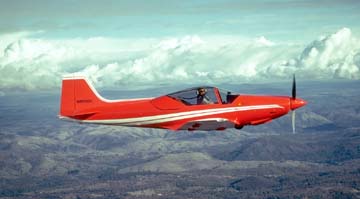
Coming back to 25 square, 160 knots indicated and a feather touch on the stick, I pull 3.5 g for the entry of my first loop. To my surprise, we pass through the top at 100 knots. The recovery is made at 4 g which calls for a climbing slow roll to the left. The roll rate doesn't come close to that of a Pitts but is still about 160°/sec at 140 knots. She's a miniature P-51! In one pass through inverted, I catch a glance of a silver shadow passing by very fast on our left. "What was that?" I ask, slightly shaken. "A P-51" replies Karl. For the first time ever I do not feel envious of a Mustang pilot. I have the full sensation of the agile flight of a hawk, and the cliché becomes inevitable. I can no longer feel where I end and where the machine starts. I am one with the wooden sculpture, revolving through the skies in the purest abandon. No sharp maneuvers, I avoid even the quick stops of a point roll. The Falco asks to be taken through swift and continuous revolutions with a light but firm pressure on the stick-the wrist always resting on the left thigh -and microscopic feet movements. The ballet ends in an authentic aerial orgasm over the Wisconsin country farms!
The pitch force gradient is not greater than 2 lbs/g at 140 knots, with positive dynamic and static stability-the latter offers little dampening, showing the traditional long period phugoid with the stick free. She is neutral in roll, and very harmonized with pitch forces. The Falco is very stable directionally and recovers quickly from yaw inputs without lateral oscillations. The rudder forces are also light and correctly proportional to pedal deflection, however all this harmonized sensitivity requires attention and care below 80 knots. I can maneuver easily in a tight climbing spiral at 75 knots indicated. Gear and flaps down, I make a tighter and tighter spiral descent to the left, over the lake. At 75-80 knots, I make a quick reversal of controls to the right, and I'm amazed at the agility and insensitivity to the configuration changes, and at the almost neutral pitch stability at low airspeeds.
I reduce the airspeed even more, now with the wings level at 65, 60 knots. Holding 15 inches and 2,000 rpm, I keep coming back on the stick until she finally gives up flying at 50 knots indicated, but not before giving a very pronounced buffet in the tail. There is no wing dropping, and the ailerons remain effective through the total unsticking of the boundary layer. With full flaps and power off, the stall attitude at 52-53 knots is not very nose high, and the airplane flies again just as you release the back pressure on the stick-no bad habits. I retract the flaps and notice that a stall in the clean configuration happens a little over 60 knots, the nose very high and with a pronounced break over the right wing, but it's always easy to recover by simply releasing the back pressure on the stick. A more abrupt movement on recovery provokes tail buffeting and a secondary stall, if you insist on a pull-back.
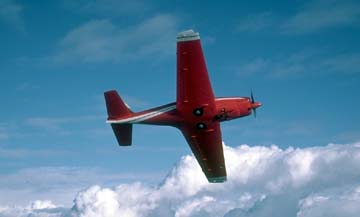
The Falco is not, therefore, a hot airplane. The wing loading is relatively low, around 17 lbs/sq ft. However she seems to be very sensitive at low airspeed and must be treated like a thoroughbred, requiring more attention than a Piper, Cessna or Mooney-mainly on the landing. The harmony and precision of the controls, helped by the extra lift provided by the slotted flaps puts this masterpiece by Stelio Frati in the ultra-safe airplane category. And all this response is obtained on aerodynamics alone, without any kind of artificial means like springs, as in the Glasair.
Shall we compare the Falco with... what? The Neiva T-25 Universal, for example, is very similar in control response, but due to a higher wing loading and higher weight, its behaviour in maneuvering still owes a lot to Frati's airplane. I think I can say the same about the Embraer Tucano, but both of these airplanes show a Frati touch-right, José Kovacs? The Tucano is heavier on the controls and less agile than a Falco, obviously. The Falco is a lot more stable laterally-or less unstable?-than a Glasair. At about 30 degrees of bank, hands off the stick, the Falco recovers somewhat but will enter a shallow descending spiral later, whereas the Glasair, due to its short fuselage and almost no dihedral, has little spiral stability, tending to tighten a hands-off spiral quickly, requiring immediate recovery.
To get some feel for the landing, we fly south to Fond-du-Lac, where there is an excellent paved runway. The traffic pattern is at 1,800 feet, and with 20 inches manifold pressure we reduce speed very slowly. This airplane is as slippery as a trout and has to be slowed gradually down to 110 knots before lowering the gear. Fond-du-Lac unicom calls our attention to "warbirds in the pattern." The Falco's visibility around all 360 degrees is excellent, a prime factor for safety in a congested traffic pattern. Downwind leg at 110, I'm a little low and feel like gaining some more speed for a "peel-off" starting low over the five Mustangs parked by the gas pump. Tranquil at my side, Karl seems to have confidence in my reasoning and suggests I slow the rate of descent by adding more power, keeping 500 fpm at 100 knots. How easy it is to handle a Falco in a traffic pattern, even with the gear down and 15° of flaps.
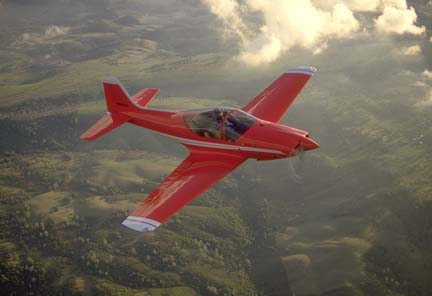
I turn final at 90 knots, reducing to 80 on a very gentle slope, turbulence and gusts jerking us on short final. Full flaps now, crossing the threshold at 70 and starting to feel for the runway. Karl recom-mends, "Mini-movements, Fernando, easy, easy!" Power-off, the Falco's attitude at the last moments of the flare is pronouncedly nose-high even with full flaps. The cowling blocks the view ahead, and the runway disappears. The tendency of the first time Falco pilot is to flare a little high. The touchdown surprises me with its gentleness and firmness at the same time. Now, all I have to do is to track true down the runway and go around, retracting the flaps slowly and putting the gear up. The Falco seems to be an easy landing airplane for feathertouch pilots, an absolutely honest and flawless airplane, but a lot more demanding than a Piper Arrow or a Beechcraft.
I climb back to 3,000 feet, on a northerly heading to Wittman Field. On this approach I feel I have assimilated the Falco, and she starts to be a part of me. I fly as naturally as riding a bicycle. I plan the descent ahead, remembering that the Falco is more demanding at this point and Oshkosh is not Fond-du-Lac. Oshkosh tower does not clear us to land, there's a P2V on a low pass over the runway and a flashing white light gun when I am turning base. Karl contacts the "glasshouse" on the radio and there comes an order, "Red Falco, we have a warbird in emergency, make another traffic entry." I obey, make a quick turn to the lake, and retract the gear. On the second try, we get a clear runway and a green light from the tower. I come in with some excess speed. The Falco floats down the runway in ground effect while Karl says, "Easy, easy, easy now!" We touch the asphalt on the mains, holding the nosewheel in the air until the last moment.
The good part of a long landing is being able to taxi back slowly, open cockpit, parading before the Staggerwings, Ryans and Wacos -the general aviaton of the thirties- in an incredible contrast with the flying Ferrari which purrs down the taxiway. Still enthralled, I cut off the engine in front of our parking slot, convinced that I have just flown a winged Stradivarius. The airplane and the musical instrument have in common the raw material, the perfection of the design and the final results-for one who knows how to play them well. Bravíssimo, Signore Frati!
|
About the Author
Brazilian Fernando Almeida has been an admirer of Stelio Frati from an early age. He was not alone-Almedia reports that during his training as an aeronautical engineer, one classmate spent his idle time sketching airplanes as he imaged Stelio Frati would design them. The student was José Kovacs, who later designed the Neiva T-25 Universal, a 300 hp military trainer which was used by the Brazilian Air Force for many years, and Kovacs based much of the overall design on the Falco. More recently Kovacs designed the Embraer T-27 Tucano, a superb 750 hp turboprop military trainer which has been sold to several air forces, including the RAF. Unlike the Universal, which bears a strong resemblence to the Falco, the Tucano is a fresh new design, but Almeida reports that one of Kovacs's design goals was to duplicate the harmonized control handling ot the Falco. Fernando Almeida writes for aviation magazines and has served as a test pilot for a number of new designs. Among these was the 180-hp all-metal "Squalo," an attempt by a homebuilder to duplicate the Falco. Almeida reports that the stabilizer was too small, and the airplane was unstable in pitch. Fernando Almeida lives in São Paulo, Brazil, and his full-time job is at Volkswagen of Brazil. Trucks! Alfred Scott |
|
|